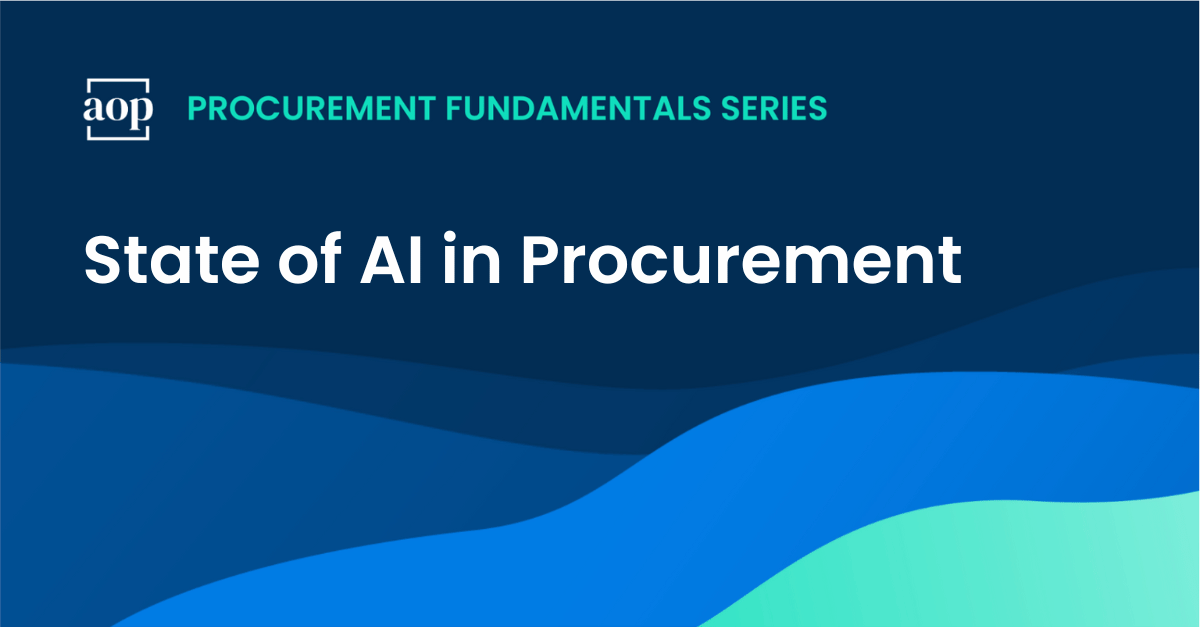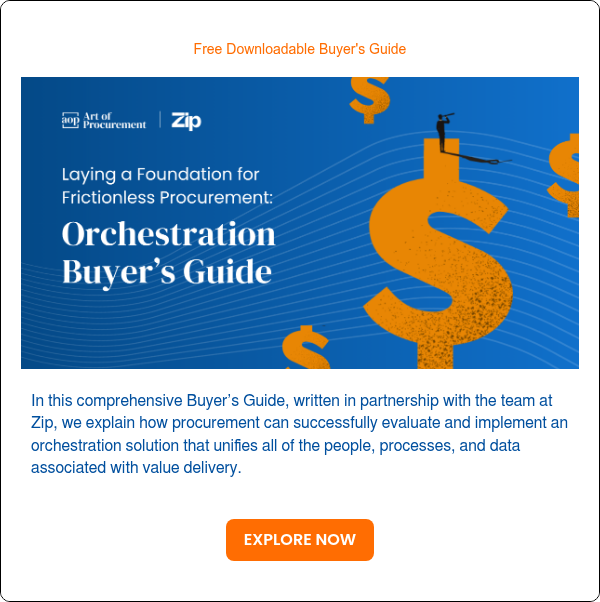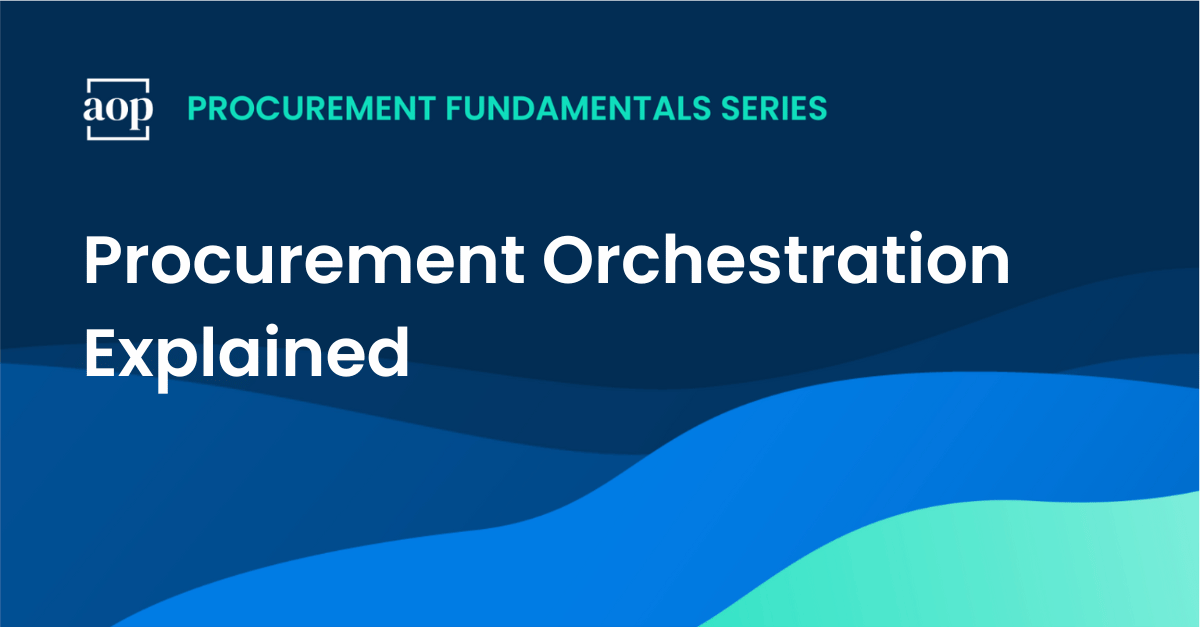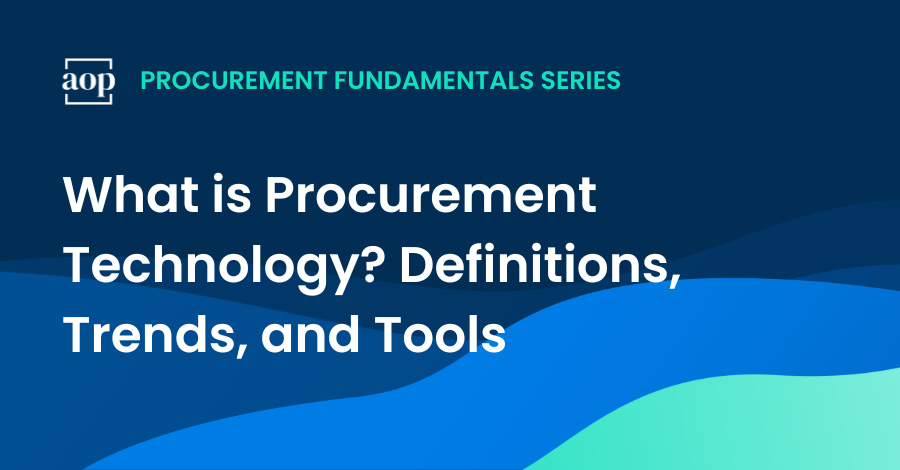
Procurement stands at a critical inflection point. In a world dominated by ever-changing tariffs, out-of-control inflation, and supply uncertainty, organizations increasingly rely on artificial intelligence (AI) to make faster, more strategic sourcing decisions. While AI has revolutionary potential, its implementation in procurement organizations is by no means painless.
In the regularly updated State of AI in Procurement we explore the core concepts every procurement executive should know. We'll examine key terms, latest research, strategic implications, and future trends that shape the AI-driven procurement function now and in the future.
What exactly is AI in procurement
AI in procurement refers to the use of artificial intelligence technologies to automate, enhance, and optimize various tasks within procurement, ultimately improving efficiency, accuracy, and decision-making. AI-powered tools can analyze data, predict market trends, streamline RFx events, and automate tasks like contract management, invoice processing, and spend analysis.
In practice, AI in procurement can mean using software with AI functionality embedded or using stand-alone generative AI tools like ChatGPT as part of everyday procurement processes. In both cases, the adoption of AI within procurement organizations has seen a rapid increase over the past 12-24 months.

According to research by AI at Wharton, weekly use of generative AI within the purchasing/procurement function increased 44 percentage points from 2023 to 2024, with 94 percent of procurement executives now using generative AI at least once a week.
Types of AI used in procurement
Artificial intelligence is a broad field of computer science that can mean different things to different people. Here are some of the core concepts you should know.

Artificial Intelligence (AI)
The overarching discipline of computer science enabling machines to simulate human intelligence through various cognitive functions and learning capabilities.
Machine Learning (ML)
A subset of AI that allows computer systems to automatically learn and improve with experience without being explicitly programmed in a supervised or unsupervised manner.
Natural Language Processing (NLP)
Technology that enables computers to understand, interpret, and generate human language. NLP can contextualize unstructured data, for example, in contract documents or supplier communications.
Deep Learning (DL)
Some of the most advanced AI algorithms process information in layers to identify patterns in complex, unstructured data. Generative AI is a specialized application of deep learning.
Agentic AI
Agentic AI systems are autonomous computer systems that can perceive their environment, make decisions, and take actions to achieve specific goals.
Robotic Process Automation (RPA)
Software technology that makes it easy to build, deploy, and manage software robots that emulate human actions. Rule-based RPA is generally not considered a field of AI.
How AI is used in procurement organizations today
While not new technology, AI adoption in procurement has accelerated dramatically over the past 12 months, propelled by major advancements in generative AI capabilities. While individual procurement executives may use generative AI tools like ChatGPT on a weekly basis, global CPOs observe that the systematic use of generative AI has not yet been rolled out across their teams.

According to the 2025 Global CPO Survey from EY, 80 percent of global CPOs plan to deploy generative AI in some capacity over the next three years, with a near-term focus on spend analytics and contract management. Currently, only 36 percent procurement organizations have meaningful generative AI implementations.
Key use cases for AI in procurement
There are two distinct sets of AI use cases in procurement: those used by procurement professionals utilizing AI tools like ChatGPT for ad-hoc daily tasks, and those where AI is integrated into workflows or procurement-specific tools.
Ad-hoc generative AI use cases in procurement:
- Document and proposal writing
- Email writing
- Scope development
- Help with RFP questions
- Analyzing data in RFP responses to support scoring
- Support building negotiation plans
- Drafting contract clauses
Seven common AI applications in procurement
1.Spend analytics
Machine learning was one of the first AI applications used in procurement, starting with spend data classification and harmonization. Today's AI-powered spend analytics deliver deeper insights:
- Automatic classification of spend into appropriate categories
- Identification of saving opportunities across business units
- Pattern recognition for maverick spend and compliance issues
- Real-time spend visibility and trend analysis combining internal and external data
2. Semi-automated sourcing
An exciting emerging application for AI is semi-automating the sourcing process or empowering stakeholders to perform sourcing tasks with AI assistance. In solutions such as Globality, the AI engages users in conversations to develop structured scope documents from informal requirements.
When RFP responses arrive, AI analyzes all submissions, scores them, and provides comprehensive comparison summaries. The process extends seamlessly into contracting with automated drafting of language, SLAs, KPIs, and other critical elements.
3. Procurement orchestration and intake
There are now intake tools and orchestration software that serve as the front door for employees who want to buy something. Rather than selecting from a catalog or guided buying interface, which hasn't fully delivered on its promise, users can simply type what they need (e.g., "I need a laptop").
The AI then turns this into something understandable, matching it against categories, coding, and backend systems to present 2-3 choices of what the user might want to buy. After selection, it guides the user through the proper procurement and approval channels for that item in the organization.
4. Contract management
Different elements of AI have made it easier to unlock the gold mine of structured and un-structured data that contracts contain:
- Automatic extraction of key terms and obligations
- Risk identification in contract language
- Compliance monitoring and alerts
- Contract renewal management and optimization
AI is being used to pull metadata out of contracts in contract management tools, making this information more accessible and actionable.
5. AI-based negotiation
Companies like Pactum are developing new methods for AI-based supplier negotiation. It's not necessarily just negotiating pricing, but can involve telling an AI bot to negotiate payment terms with a cohort of suppliers, running automated negotiations around various contract terms.
6. Supplier management
In the broad scope of supplier management, AI can both improve the quality of supplier data and help procurement teams to manage suppliers more effectively:
- Supplier risk assessment using multiple data sources
- Supplier performance monitoring and predictive analytics
- Identification of new potential suppliers or consolidation opportunities
- More efficient communication practices and supplier data management
8. Strategic decision support
AI transforms decision-making by providing data-driven insights based on internal and external information. For strategic sourcing, AI can analyze supplier capabilities, market conditions, and risk factors to recommend optimal approaches.
- Data-driven insights for sourcing strategies
- Better supplier selection based on comprehensive analysis
- Improved negotiation positions with market intelligence
- Risk-aware decision making with predictive analytics
Examples of recent AI investments in procurement
While there is a lot of enthusiasm about AI's potential, recent research from ISG's 2025 State of Enterprise AI Adoption study reveals that procurement represents just 6 percent of AI use cases across enterprise functions. This finding, drawn from analysis of 1,200 AI implementations in enterprise businesses, positions procurement behind sales (16 percent), product management (12 percent), and operations (10 percent) in terms of AI deployment activity.
AI investments in procurement gaining traction
The ISG research examined AI use cases across various back and middle office functions, several of which directly impact procurement operations. Here's what the data reveals about investment levels and production readiness:
- Forecasting and budgeting represents 5 percent of AI use cases studied, with 45 percent of these implementations now in production. Organizations are investing an average of $1.0 million per use case in this area, reflecting the strategic importance of accurate demand planning and budget management across finance and business functions.
- Supplier management accounts for 4 percent of AI use cases, though only 8 percent have reached production status. Despite this relatively low production rate, average investments of $2.6 million per use case signal strong organizational commitment to transforming how they engage with their supply base.
- Supplier risk assessment and monitoring shows the highest production rate among procurement-adjacent functions, with 58 percent of use cases in production. This area represents 3 percent of overall AI use cases in back and middle office functions, with average investments of $2.0 million.
What these investments mean for procurement teams
The relatively modest 6 percent share of enterprise AI use cases suggests procurement has room to grow its AI footprint. At the same time, the substantial investment levels, averaging $1.0 million to $2.6 million per use case in procurement-related areas, demonstrate that when organizations do commit to procurement AI initiatives, they invest meaningfully.
Benefits and value of AI in procurement
Artificial intelligence, particularly generative AI, is rapidly reshaping how technology is used in businesses and how work gets done. It brings unprecedented opportunities to transform manual processes, enhance decision-making capabilities, and drive strategic value.

It’s perhaps no surprise that CPOs are very bullish on investing in AI. According to the 2025 Annual ProcureCon CPO Report, 80 percent of CPOs consider investing a priority over the next 12 months, with 66 percent of CPOs considering it a high priority.
1. Efficiency gains
AI can dramatically improve operational efficiency by automating routine tasks and streamlining repetitive workflows.
- Reduction in manual processing time for routine tasks
- Faster procurement cycles with automated workflows
- Improved resource allocation to higher-value activities
- Enhanced productivity across procurement teams
In an ideal world, this efficiency would allow procurement teams to manage higher transaction volumes while redirecting talent toward strategic initiatives that deliver greater organizational value.
2. Cost reduction
AI can enable more sophisticated approaches to spend management by augmenting the analytical capabilities of procurement professionals and reducing the risk of human error.
- Identify savings opportunities missed by the human eye
- Support category management initiatives with data-driven insights
- Lower processing costs for transactions or approvals
- Decreased errors and fewer reworked expenses
3. Risk mitigation
AI algorithms can be programmed to monitor supplier financial health, geopolitical developments, and market signals to detect early warning signs of emerging risks.
- Early warning of supplier financial or operational issues
- Proactive identification of supply chain disruptions
- Compliance monitoring and automatic alerts
- Fraud detection and prevention
4. Fact-based supplier relationships
AI can help procurement teams manage supplier relationships more effectively through:
- More consistent and transparent communication
- Performance-based supplier development
- Collaborative innovation opportunities
- Strengthened partnerships built on data sharing
So, where does generative AI bring most value?
Recent research from Deloitte's 2025 Global CPO Survey reveals where procurement executives see the greatest GenAI value.
Enhanced decision-making and improved productivity lead the way at 67.68% and 49.43% respectively.
Better management of spend follows at 31.56%, while cost optimization ranks fourth at 28.90%.

These findings show procurement leaders prioritize strategic capabilities over pure cost savings when evaluating GenAI investments.
Challenges and barriers to AI adoption
At the same time as enthusiasm for AI is growing, its disruptive nature means that traditional roles and responsibilities in the workplace need to be redesigned, and many procurement professionals will need support and training to adapt to these new ways of working. Some of the most significant challenges for AI relate to the way humans and machines learn to interact with each other.
Data quality issues
AI systems are only as good as the data they're trained on. Some of the most common procurement data quality challenges include:
- Inconsistent data formats across systems
- Incomplete or inaccurate historical information
- Lack of standardized taxonomy for classification
- Poor master data management practices
However, procurement teams shouldn't use data quality as an excuse for inaction. Bad data is often cited as a barrier, but it will probably never be 100 percent accurate. Organizations need to find ways to mitigate data quality issues rather than using them as reasons not to move forward with AI initiatives.
Integration complexities
Most procurement organizations operate in complex technology environments:
- Legacy systems with limited API capabilities
- Multiple ERP instances across business units
- Disparate procurement tools requiring integration
- Data silos preventing comprehensive analysis
If you have technological debt caused by siloed procurement systems, the challenge is only going to get worse with AI. In the current state, AI systems can’t solve your integration challenges, and require secure access to any data you provide them.
Security concerns
AI brings with it major information security risks. Fears around what happens when information, insights, and IP goes into AI systems remain significant - and many central IT departments have strict guidance on what data can be exposed to self-service AI solutions and generative AI tools. For example, increasingly IT teams are instructing executives to use fully licensed instances of Microsoft Copilot instead of using free (but insecure) versions of ChatGPT.
Validating AI outputs
AI isn’t a magical “easy button” that can be activated in one go. There's still a need for a trust-but-verify approach with any AI outputs. Procurement professionals need to understand how to use the outputs of AI and not just take everything it has generated as the gospel truth.
Change resistance
Even when you’ve solved your data and integration challenges, AI needs to fit into your ways of working. Human factors often present some of the greatest implementation challenges:
- Fear of job displacement or role changes
- Comfort with existing processes and tools
- Skepticism about AI capabilities and benefits
- Reluctance to trust automated recommendations
Skills gaps
Many procurement teams approach AI with open arms. Still, AI implementation requires new capabilities within procurement teams:
- Data science and analytics expertise
- Technical understanding of AI limitations
- Change management experience
- Digital transformation skills
Understanding the art of the possible
A significant barrier is just simply understanding what's possible with AI. There's so much noise around AI that there's a hunger for real-world use cases that have truly made a difference and provide a pathway for experimentation.
The adoption chasm
There's a huge gap between early adopters and those watching and waiting. Many organizations think their procurement team is already relatively immature, so they feel they need to fix other fundamentals before considering new AI technology. However, this isn't necessarily true - organizations can skip technology generations and adopt AI even if other processes aren't fully mature.
Emerging and future AI Applications in Procurement
AI agents and virtual procurement advisors
The concept of AI Agents represents one of the most transformative developments on the horizon. These aren't just chatbots but sophisticated virtual team members trained on comprehensive procurement datasets, market intelligence, and organizational knowledge.
Key capabilities emerging in this space:
- Contextual understanding of your organization's spending history and preferences
- Ability to proactively identify opportunities based on market conditions and internal data
- Procurement strategy consultation that combines historical outcomes with current market conditions
- Knowledge retention that preserves institutional wisdom even as team members change roles
One area where the role of AI Agents is likely to play a big part is category management. According to McKinsey, autonomous category agents can capture 15 to 30 percent efficiency improvements through the automation of non-value-added activities.
Autonomous end-to-end sourcing
The future points toward systems capable of managing entire sourcing cycles with minimal human intervention for certain categories:
Developing capabilities include:
- Automatic detection of sourcing opportunities by monitoring spend patterns, contract expirations, and market conditions
- Intelligence-driven wave planning that prioritizes categories based on potential ROI
- Self-executing RFx processes for standard categories with autonomous supplier selection
- Dynamic pricing models that automatically adjust based on real-time market conditions
- Continuous performance monitoring and contract optimization without manual intervention
A number of procurement software solutions offer a degree of autonomous sourcing. Future systems will close the loop completely for routine purchasing categories, freeing procurement teams to focus on strategic suppliers and innovative partnerships.
Cognitive supplier intelligence
Beyond basic supplier data management, cognitive supplier intelligence will transform how procurement teams understand and engage with their supply base:
Emerging features in this area:
- "Digital twin" representations of key suppliers that model their business operations, financial health, and risk profiles
- Predictive analytics for supplier performance that identify potential issues before they impact operations
- Conversational interfaces that allow natural language queries about supplier relationships and history
- Automatic identification of innovation opportunities and collaborative potential with suppliers
- Cross-supply chain visibility that reveals interdependencies and potential cascade failure points
This evolution will address a critical pain point in procurement: the loss of institutional knowledge when team members change roles. By creating persistent, accessible intelligence about supplier relationships, organizations can maintain continuity and strategic advantages over time.
Hyper-personalized market and price intelligence
AI systems are increasingly able to curate highly relevant market intelligence customized to specific procurement roles and categories:
Developing capabilities:
- Personalized news feeds and market alerts tailored to your specific category and supplier portfolio
- Automatic translation of market events into potential impacts on your specific supply chain
- Scenario modeling that translates geopolitical developments into procurement risk assessments
- Competitive intelligence that identifies how peer organizations are adapting their procurement strategies
- Price trend forecasting that combines internal and external data to predict optimal sourcing timing
This level of personalization will dramatically increase procurement teams' ability to make proactive rather than reactive decisions, with AI serving as an early warning system for both risks and opportunities.
Embedded ethical and sustainable procurement
Future AI applications will make ethical and sustainable procurement practices more accessible and actionable.
Emerging capabilities:
- Automated ESG scoring and monitoring across the entire supply base
- Carbon footprint calculation and optimization recommendations at the sourcing stage
- Diversity spending analysis with AI-driven recommendations for improvement
- Circular economy opportunity identification within existing supplier relationships
- Regulatory compliance monitoring that adapts to changing global requirements
These tools will transform sustainability from a reporting exercise to an embedded part of everyday procurement decisions, helping organizations meet increasingly stringent requirements from both regulators and customers.
Lessons from MIT: How to Avoid Common AI Pilot Traps
MIT’s 2025 State of AI in Business study delivers a stark warning: despite $30–40 billion in recent investments in generative AI, 95 percent of enterprise pilots deliver no measurable ROI. Here are some key traps to avoid, according to the MIT research:
- Adoption is high, transformation is low: Over 80 percent of enterprise firms pilot generative AI, but only 5 percent of AI pilots have reached mature production-stage adoption.
- Emergence of “shadow AI”: 90 percent of employees use personal AI tools at work, while only 40 percent of firms have official subscriptions.
- Many pilots stall because of a learning gap: A reason why many generative AI pilots fail is because most tools don’t learn or adapt. This leads to a need to verify the quality of AI outputs, reducing their value to business.
- Build vs. buy: AI projects built with external partnerships are ~2× more successful than internal builds.
- Back-office ROI: 50 percent of generative AI budgets go to sales and marketing, even though back-office automation often yields better ROI.
What this means for procurement
Procurement teams need to shift how they frame, fund, and deploy AI. Instead of chasing broad pilots or shiny demos, they should:
- Anchor AI projects in measurable business outcomes e.g., cycle time reduction, BPO spend elimination, compliance gains
- Leverage existing “shadow AI” momentum. Formalize and secure the tools teams are already using effectively. For example, you can switch from individual ChatGPT licenses to an organization-wide Microsoft Copilot.
- Prioritize learning-capable systems. Invest in AI that adapts to procurement workflows and improves over time, not static tools that repeat the same mistakes.
- Treat providers like strategic partners, not software providers. Encourage co-development, workflow integration, and accountability for outcomes.
- Build the case for back-offce improvement. Highlight that procurement process improvements often deliver fast, more tangible ROI than front-office use cases.
Bottom line on the state of AI in procurement
AI is no longer a future trend; it is embedded in the everyday work of procurement organizations. With 94 percent of procurement executives using generative AI weekly and 80 percent of CPOs prioritizing AI investments, organizations that delay implementation risk falling behind competitors who are gaining compounding advantages.
The greatest value comes from augmenting—not replacing—procurement professionals. By automating routine tasks and providing superior analytics, AI frees teams to focus on strategic activities where human judgment adds the most value.
The most successful organizations are reimagining procurement around AI capabilities rather than simply automating existing processes. This shift is elevating procurement's strategic importance by enabling deeper insights, proactive risk management, and stronger supplier relationships.






.png)